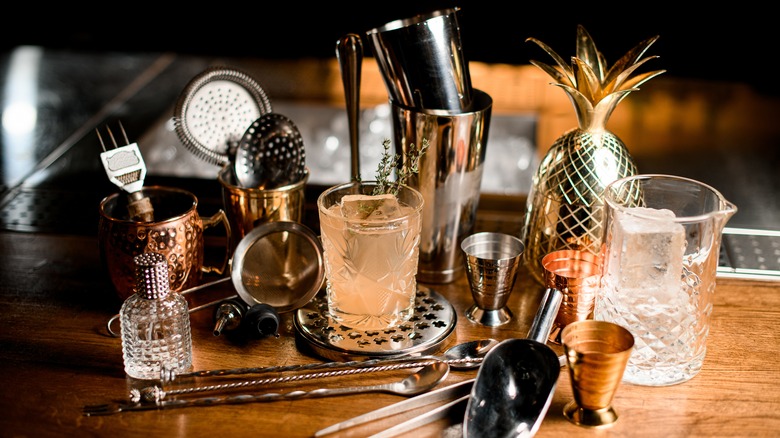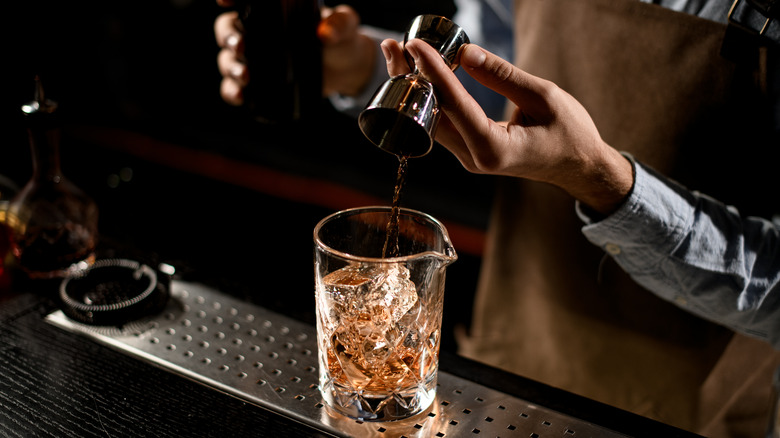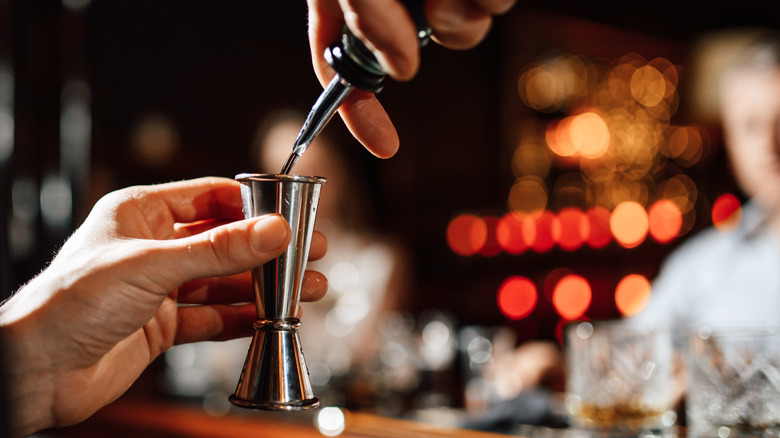The Reason Cocktail Jiggers Come In Different Sizes
Every bartender has a trusty toolkit to draw from when crafting delicious drinks, and among those specialized spoons, shakers, and strainers are one or two jiggers. A fairly unique piece of equipment, there are five main types of jiggers: American (classic), Japanese, pub/thimble, measuring cup, and bell jigger.
The sizes and shapes vary, but the choice of jigger largely depends on personal preference and the type of drinks a bartender makes. The hourglass-shaped measuring tool resembles two cones stuck together at the base, with the measuring cup and pub jigger being the exceptions, as the former looks like a mug, and the latter resembles a shot glass. For dual-sided styles, the size disparity makes this one nifty item useful for measuring multiple cocktail ingredients, and many jiggers have various measurement lines to ensure precision.
You might see a mixologist flipping a jigger between their fingers while crafting a drink — that's the ergonomic idea behind the design. However, not all jiggers are created equal, and the different sizes serve various purposes in drink recipes. The mixing of many classic cocktails becomes easier with a multi-purpose measuring tool on hand. The larger side of a classic American jigger is a standard shot: one and a half ounces. The smaller end measures three-quarters of an ounce. Japanese jiggers are larger, with two full ounces on one side and a single ounce on the other, with smaller measurements labeled below the rim.
Cocktail ratios require precise measurements
Jiggers are designed for convenience and consistency in drink mixing, which is important for both professionals and at-home bartenders. They allow mixologists to measure booze without relying on separate glasses. Shot glasses can vary in size, but jiggers are standardized and relatively easy to use. The cone shape and the wide mouth allow for mess-free pouring, and the dual-sided design makes it easy to pour one liquid, and then immediately measure another.
Bartenders often have both the larger Japanese and smaller American jiggers on hand for complex cocktails, since the disparity in their measurements makes them useful for complicated drinks. Bell jiggers are popular for their wide cups and vintage flair. And let's be honest, using a jigger looks cool. Nobody wants to measure fractions of an ounce with a dinky teaspoon, after all.
The three-two-one rule of cocktails is a tried-and-true ratio beloved by cocktail gurus. Many traditional and custom cocktails can be crafted using three parts strong liquor, two parts sweet liquor, and one part fruit juice or sweetener. For example, a sidecar, cosmo, and margarita (be sure to give your marg a good shake!) can all be made by following this formula. A jigger makes these ratios easy to nail consistently, with the larger cup for liquors, and the smaller side for sweeteners like simple syrup or agave. Japanese jiggers are popular for their larger size and measurement markings, while American jiggers are useful for measuring standard shots.
Cornelius, the cocktail gadget genius
Cornelius P. Dungan patented the two-sided cocktail jigger in Chicago all the way back in 1893. Before his ingenious contraption, smaller glasses were the best tools for bartenders measuring booze. Mixing drinks was messy and inconvenient, and Dungan's creation quickly spread to bars nationwide before going global. The origins of the name for this booze-measuring thingamajig are disputed, with credit often going to British sailors who nicknamed their daily alcohol rations after the jiggermast sails.
Modern jiggers come in many materials and shapes, designed for both style and practicality, but the original double-cone design remains popular. In specialty bartending stores, you'll find jiggers made of copper, glass, plastic, and the more common stainless steel. Measuring cup styles and thimble jiggers are common in establishments not overly concerned with fashion, while American, Japanese, and bell styles can be seen in bars where aesthetics and quick mixing are paramount. It may take some practice to use a cocktail jigger like a professional, but mastering this skill is invaluable for anyone who enjoys making drinks, and making them well.



